Abstract
Randomized complete block (RCB) design is the most widely used experimental design in biological sciences. As number of treatments increases, the block size become larger and it looses the capacity to control the variance within block, which is its original purpose. A method known as post hoc blocking could be used in these cases to improve the genetic parameter estimation and thus obtain an unbiased assessment of the performance of a given treatment. In trufgrass breeding, as other breeding program, this is a common challenge. The goal of this study was to test the capacity of different post hoc blocking designs to improve the genetic parameter estimation of zoysiagrass (Zoysia spp.). We evaluated two post hoc blocking designs; row–column (R–C) and incomplete block (IB) designs on five genotype trials located in Florida. The results showed that post hoc R–C design had superior model fitting than both the original RCB and the post hoc IB designs when studied at the single measurement level and at the site level. The narrow-sense heritability (0.24–0.40) and the genotype-by-measurement correlation (0.57–0.99) did not change significantly when R–C was compared to the original RCB design. The ranking of the top performing genotypes changed considerably when comparing RCB to R–C design, but the degree depended on the location analyzed. We conclude that the change in the ranking of the top (potentially select individuals) is coming from the better control of intra-block environmental variation, and this could potentially have a significant impact on the breeding selection process.




Similar content being viewed by others
References
Anderson VL, McLean RA (1974) Design of experiments: a realistic approach, vol 5. CRC Press, Boca Raton
Braman S, Duncan R, Engelke M (2000) Evaluation of turfgrass selections for resistance to fall armyworms (Lepidoptera: Noctuidae). HortScience 35:1268–1270
Brede D (2000) Turfgrass maintenance reduction handbook: sports, lawns, and golf. Wiley, Hoboken
Brede AD, Sun S (1995) Diversity of turfgrass germplasm in the Asian Pacific Rim countries and potential for reducing genetic vulnerability. Crop Sci 35:317–321
Busey P, Reinert J, Atilano R (1982) Genetic and environmental determinants of zoysiagrass adaptation in a subtropical region. J Am Soc Hortic Sci 107:79–82
Clewer AG, Scarisbrick DH (2013) Practical statistics and experimental design for plant and crop science. Wiley, New York
Cullis BR, Warwickl JL, Fisher JA, Read BJ, Gleeson AC (1989) A new procedure for the analysis of early generation variety trials. Appl Stat 38(2):361–375
Ebdon J, Gauch H (2002) Additive main effect and multiplicative interaction analysis of national turfgrass performance trials. Crop Sci 42:497–506
Fan X-M, Kang MS, Chen H, Zhang Y, Tan J, Xu C (2007) Yield stability of maize hybrids evaluated in multi-environment trials in Yunnan, China. Agron J 99:220–228
Forbes I (1952) Chromosome numbers and hybrids in Zoysia. Agron J 44:194–199
Fu Y-B, Clarke GPY, Namkoong G, Yanchuk AD (1998) Incomplete block designs for genetic testing: statistical efficiencies of estimating family means. Can J For Res 28:977–986
Fu Y-B, Yanchuk AD, Namkoong G (1999) Incomplete block designs for genetic testing: some practical considerations. Can J For Res 29:1871–1878
Gezan SA, Huber DA, White TL (2006) Post hoc blocking to improve heritability and precision of best linear unbiased genetic predictions. Can J For Res 36:2141–2147
Gilmour AR, Cullis BR, Verbyla AP (1997) Accounting for natural and extraneous variation in the analysis of field experiments. J Agric Biol Environ Stat 2(3):269–293
Gilmour AR, Gogel B, Cullis B, Thompson R, Butler D (2009) ASReml user guide release 3.0. VSN International Ltd, Hemel Hempstead, UK
Green D, Fry J, Pair J, Tisserat N (1994) Influence of management practices on Rhizoctonia large patch disease in zoysiagrass. HortScience 29:186–188
John J, Eccleston J (1986) Row–column α-designs. Biometrika 73:301–306
Kravchenko A, Robertson G, Snap S, Smucker A (2006) Using information about spatial variability to improve estimates of total soil carbon. Agron J 98:823–829
Leon RG, Unruh JB, Brecke BJ, Kenworthy KE (2014) Characterization of fluazifop-P-butyl tolerance in zoysiagrass cultivars. Weed Technol 28:385–394
Liddle AR (2007) Information criteria for astrophysical model selection. Mon Notices R Astron Soc 377:L74–L78
Marcum KB, Engelke M, Morton SJ, White RH (1995) Rooting characteristics and associated drought resistance of zoysiagrasses. Agron J 87:534–538
Marcum KB, Anderson SJ, Engelke M (1998) Salt gland ion secretion: a salinity tolerance mechanism among five zoysiagrass species. Crop Sci 38:806–810
Montgomery DC, Montgomery DC, Montgomery DC (1984) Design and analysis of experiments. Wiley, New York
Morris KN, Shearman RC (1998) NTEP turfgrass evaluation guidelines. In NTEP turfgrass evaluation workshop, Beltsville, MD, pp 1–5
Morton S, Engelke M, White R (1991) Performance of four-warm-season turfgrass genera cultured in dense shade. III. Zoysia spp. Tex Agric Exp Stn 4894:51–52
Patterson H, Hunter E (1983) The efficiency of incomplete block designs in National List and Recommended List cereal variety trials. J Agric Sci 101:427–433
Patton AJ, Reicher ZJ (2007) Zoysiagrass species and genotypes differ in their winter injury and freeze tolerance. Crop Sci 47:1619–1627
Qian Y, Engelke M, Foster M (2000) Salinity effects on zoysiagrass cultivars and experimental lines. Crop Sci 40:488–492
Qiao C, Basford K, DeLacy I, Cooper M (2000) Evaluation of experimental designs and spatial analyses in wheat breeding trials. Theor Appl Genet 100:9–16
Raymer P, Braman K (2006) Breeding seashore paspalum for recreational turf use. JL Nus (ed.), p. 36
Reinert J, Engelke M (1992) Resistance in zoysiagrass (Zoysia spp.) to the tropical sod webworm (Herpetogramma phaeopteralis). PR-Texas Agricultural Experiment Station (USA)
Schabenberger O, Gotway CA (2004) Statistical methods for spatial data analysis. CRC Press, Boca Raton
Schwartz BM, Kenworthy KE, Engelke M, Genovesi AD, Quesenberry KH (2009) Heritability estimates for turfgrass performance and stress response in Zoysia spp. Crop Sci 49:2113–2118
Schwartz BM, Kenworthy KE, Engelke M, Genovesi AD, Odom RM, Quesenberry KH (2010a) Variation in 2C nuclear DNA content of Zoysia spp. as determined by flow cytometry. Crop Sci 50:1519–1525
Schwartz BM, Kenworthy KE, Crow WT, Ferrell JA, Miller GL, Quesenberry KH (2010b) Variable responses of zoysiagrass genotypes to the sting nematode. Crop Sci 50:723–729
Simon R, Maitournam A (2004) Evaluating the efficiency of targeted designs for randomized clinical trials. Clin Cancer Res 10:6759–6763
Stroup WW, Mulitze DK (1991) Nearest neighbor adjusted best linear unbiased prediction. Am Statist 45(3):194–200
Watkins E, Fei S, Gardner D, Stier J, Bughrara S, Li D, Bigelow C, Schleicher L, Horgan B, Diesburg K (2011) Low-input turfgrass species for the north central United States. Appl Turfgrass Sci 8:0
Welham SJ, Gezan SA, Clark SJ, Mead A (2014) Statistical methods in biology: design and analysis of experiments and regression. CRC Press, Boca Raton
White R, Engelke M, Anderson S, Ruemmele B, Marcum K, Taylor G (2001) Zoysiagrass water relations. Crop Sci 41:133–138
Williams ER, Matheson AC, Harwood CE (2002) Experimental design and analysis for tree improvement. CSIRO publishing, Clayton
Author information
Authors and Affiliations
Corresponding author
Rights and permissions
About this article
Cite this article
Xing, L., Gezan, S., Kenworthy, K. et al. Improved genetic parameter estimations in zoysiagrass by implementing post hoc blocking. Euphytica 213, 195 (2017). https://doi.org/10.1007/s10681-017-1984-3
Received:
Accepted:
Published:
DOI: https://doi.org/10.1007/s10681-017-1984-3




